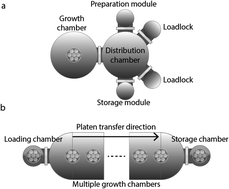A high throughput, linear molecular beam epitaxy system for reduced cost manufacturing of GaAs photovoltaic cells: will GaAs ever be inexpensive enough?†
Abstract
Solar cells based on GaAs and related compounds provide the highest reported efficiency single junction and multijunction solar cells. However, the cost of the cells is prohibitive when compared with Si and other thin film solar technologies. One significant differentiator is the high cost required to grow the epitaxial layers. Here, we propose a molecular beam epitaxy (MBE) system design that has the potential to increase the epitaxial layer growth throughput, thereby significantly reducing production costs. A rack-and-pinion based linear transfer system sequentially transfers multiple substrate platens between interconnected growth positions within the chamber, thereby synchronously growing layers on many wafers in the desired order and at the required thicknesses. The proposed linear MBE platform is the basis for a realistic analysis of GaAs single junction photovoltaic cell production cost. Our model projects a nearly 55% cost reduction in epitaxial growth via linear MBE when compared to conventional MBE, and a 85% reduction when further process optimization is assumed and combined with non-destructive epitaxial lift off. Even when considering all of these factors in an optimistic light, the cost of unconcentrated GaAs solar cells using any existing growth process is unlikely to drop below $3 per Wp in the foreseeable future.



 Please wait while we load your content...
Please wait while we load your content...
